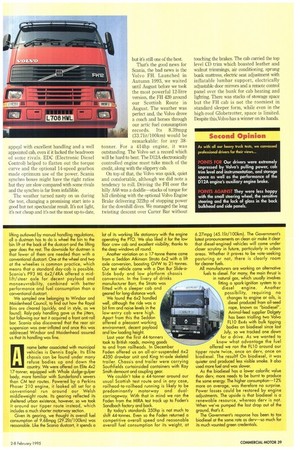TRACTIVE UNITS
Page 40

Page 41

If you've noticed an error in this article please click here to report it so we can fix it.
e weren't exactly inundated with tractive units for test last year but what we lacked in quantity we made up for in quality. Top. weight 38-tonners tend to be the staple diet for our three-day Scottish test route. Recognising that many distribution operations such as supermarket and parcel deliveries carry more bulk than weight, Leyland Daf offered up a 75.300 for test at 32 tonnes. Although it displayed all the virtues of the 75/85 series, we could not fairly compare it with the 38-tonners we tested.
Mercedes-Benz has also scored a fleet hit with its 11-litre vee-six 1834. We took the Merc around Scotland at the beginning of the year and encountered some really poor weather conditions. As our tester commented: "ASR (anti-wheelspin control) proved its worth by maintaining traction on icy, snow-dusted roads." The weather took its toll on the results, but that considered, it was a creditable performance in difficult conditions.
Turning from one of the Goliaths of the industry to one of the Davids, ERF's EC range made its debut in May 1993, but we had to wait until last summer for the highroof Olympic variant. The Olympic effectively made use of the space over a standard cab under its airflow package to make extra cab space. It had some clever packaging ideas such as a swivelling passenger seat with pull-out table beneath the bottom bunk. It was pretty well kitted out too, with twin sprung bunks, heated seat, electrically operated roof vent and a switch panel over the bunks for the radio and lights. In addition, there was an infra-red remote control to switch radio stations from the bunk.
Our test vehicle was fitted with Cummins 14-litre 410hp engine with Jake brake, mated to an Eaton SAMT gearbox. This engine lacked the Celect control electronics but offers plenty of torque. Mated to the Eaton semiautomated shift, it's a desirable combination. The SMC plastic panels used in the cab construction endowed the ERF with a 10year cab warranty. This was an appealing truck and probably the best ERF yet.
For many drivers there's only one truck to have and that's a Scania. Tag-axle 6x2s are popular with owner-drivers because of the flexibility they offer. Add in the top-of-therange Topline Streamline cab and 380hp and the result is a highly desirable 38-tormer.
As we expected, the Scania oozed driver appeal with excellent handling and a well appointed cab, even if it lacked the headroom of some rivals. EDC (Electronic Diesel Control) helped to flatten out the torque curve and the optional 14-speed gearbox made optimum use of the power. Scania synchro boxes might have the right ratios but they are slow compared with some rivals and the synchro is far from infallible.
The weather turned nasty on us during the test, changing a promising start into a good but not spectacular result. It's not light, it's not cheap and it's not the most up-to-date, but it's still one of the best That's the good news for Scania, the bad news is the Volvo FH. Launched in Autumn 1993, we waited until August before we took the most powerful 12-litre version, the FH 420 around our Scottish Route in August. The weather was perfect and, the Volvo drove a coach and horses through our artic fuel consumption records. Its 8.39mpg (33.71it/100km) would be remarkable: for any 38tonner. For a 414hp engine, it was outstanding. The Volvo set a record which will be hard to beat. The D12A electronically controlled engine must take much of the credit, along with the slippery cab.
On top of that, the Volvo was quick, quiet and comfortable, although we did note a tendency to roll. Driving the FH over the hilly A68 was a doddle—stacks of torque for hill climbing with the optional Volvo Engine Brake delivering 322hp of stopping power for the downhill dives, We managed the long twisting descent over Carter Bar without touching the brakes. The cab carried the top level CD trim which boasted leather and walnut trimmings, air conditioning, sprung bunk mattress, electric seat adjustment with inflatable lumbar support, electrically adjustable door mirrors and a remote control panel over the bunk for cab heating and lighting. There was stacks of stowage space but the FH cab is not the roomiest in standard sleeper form, while even in the high-roof Globetrotter, space is limited. Despite this,Volvo has a winner on its hands,
































































































